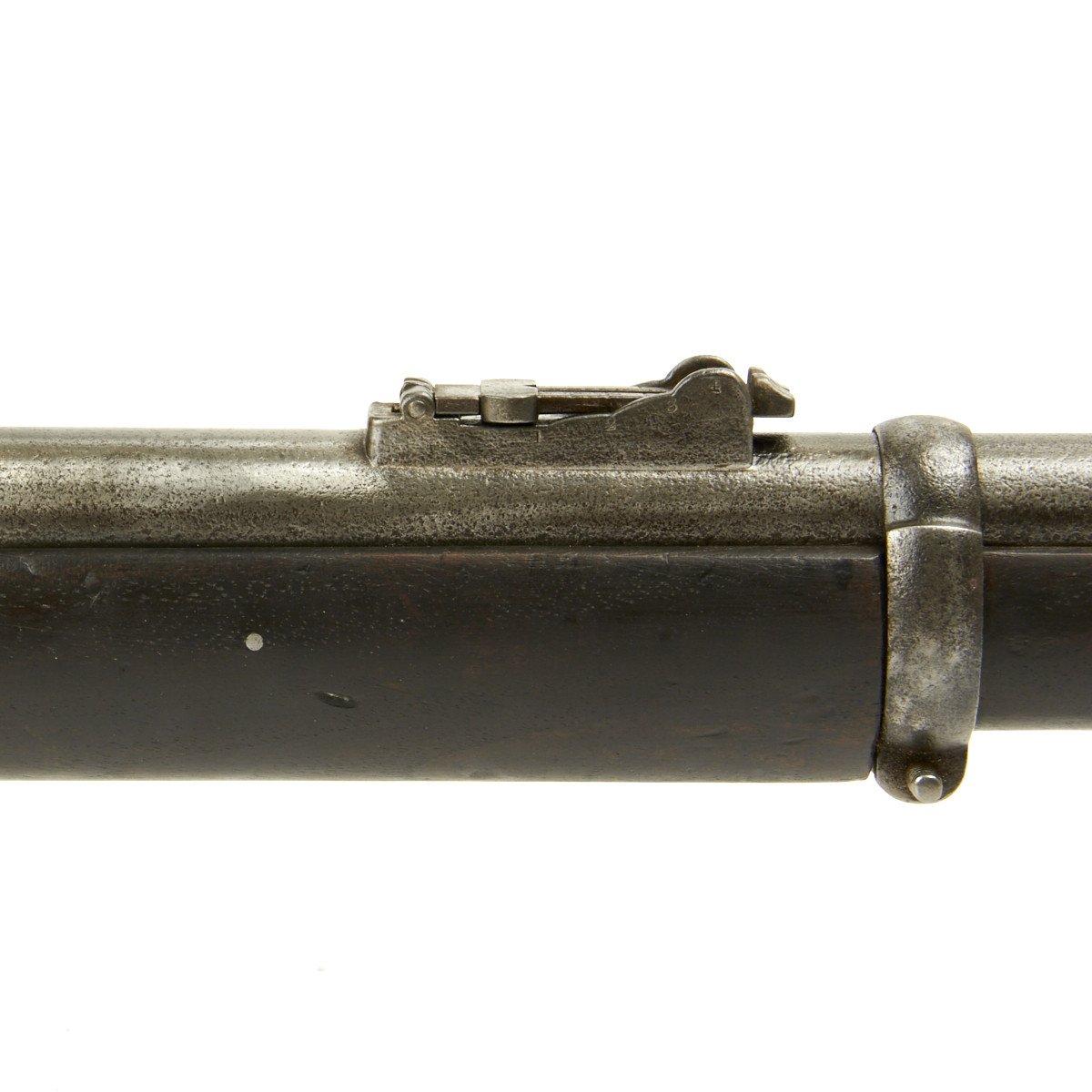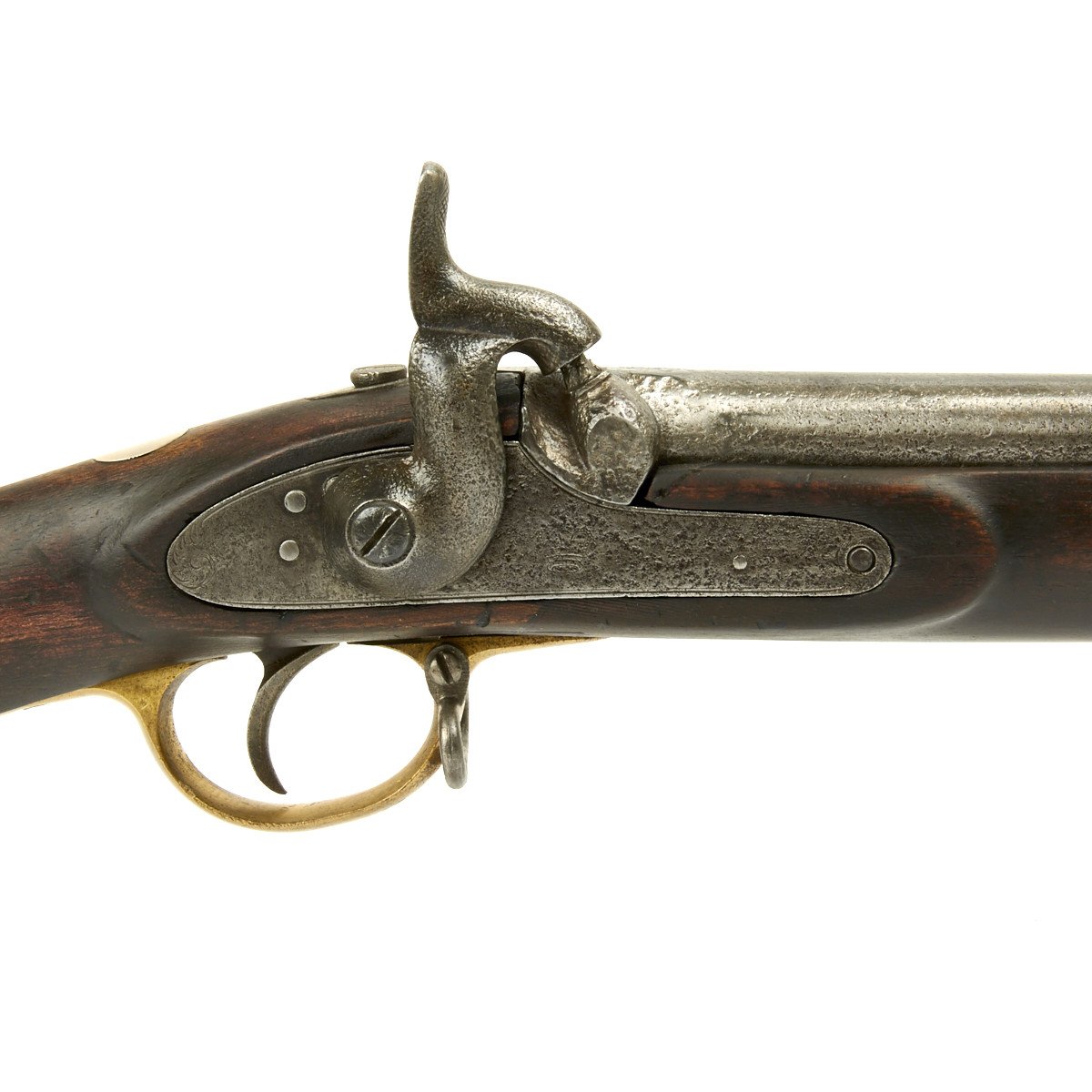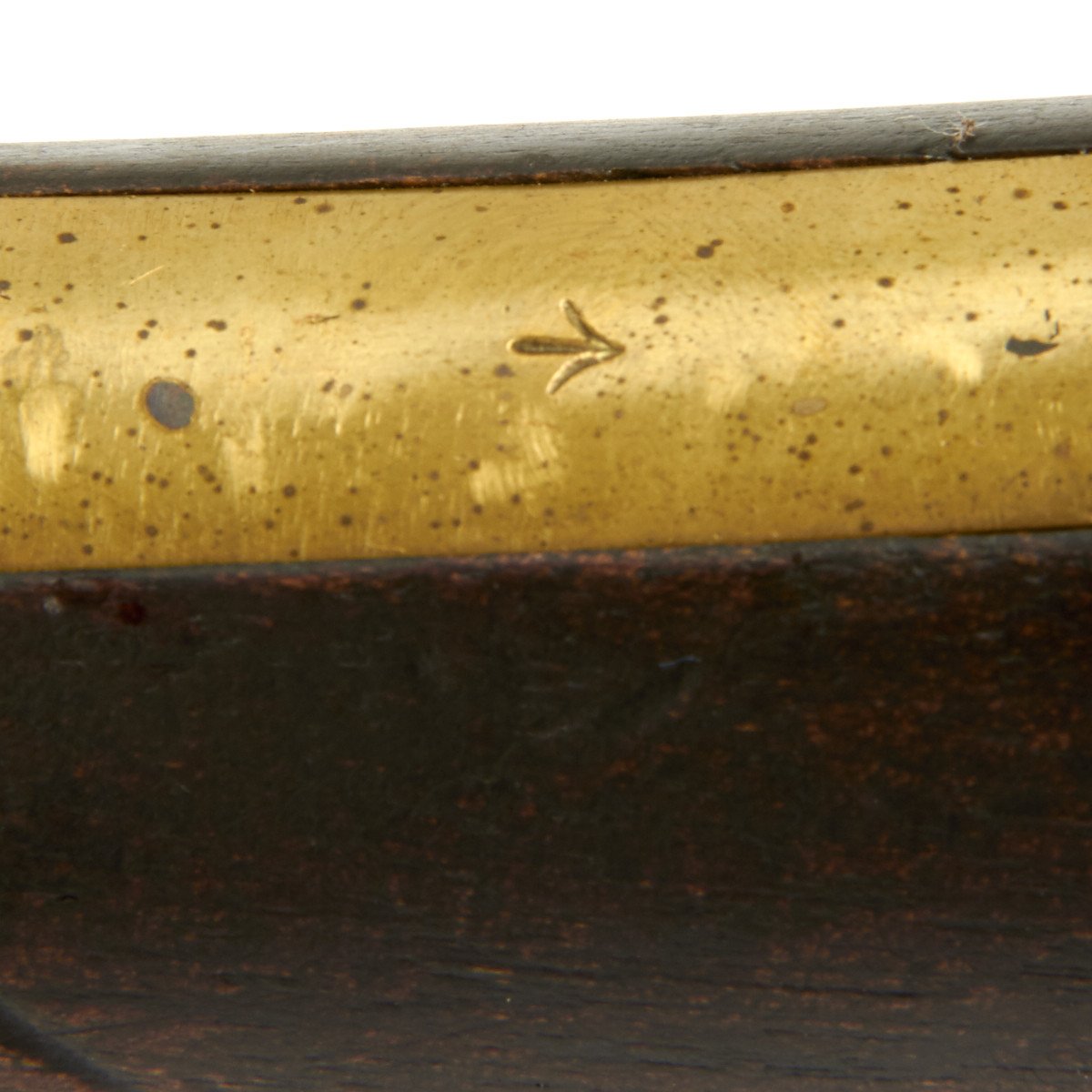Original British Pattern 1856 Short Rifle with Yataghan Saber Bayonet Original Items
$ 1.895,00 $ 473,75
Original Item: Only One Available. A very common weapon used in the U.S. Civil War, the Pattern 1856 Short Rifle was the standard British military rifle of the era, and had a 33 barrel, with a .577 caliber bore which was rifled with 3-groove, progressive depth rifling. The rear sight was graduated to 1,100 yards (rifle musket sights were graduated to 1,000 yards), and was set just behind the rear barrel band; further forward on the barrel than the sights used on the rifle musket.
The rifle was equipped with a bayonet lug on the right side of the barrel, near the muzzle, to accommodate a Yataghan blade saber bayonet. The earliest production rifles had a short key or lead forward of the actual lug, but this feature was quickly eliminated and the majority of P-1856 rifles have lugs without that short guide. The rifle had a rear sling swivel attached to a lug, screwed into the rear of the extended iron trigger guard tang, and the upper swivel attached to the upper barrel band. As with the P-1853 rifle muskets, the iron mounted rifles had blued barrels and color case hardened locks and hammers. The furniture (trigger guard, butt plate, stock escutcheons, nose cap, etc) of the iron mounted rifles was made of iron rather than brass, and was color casehardened as well. Due to the difficulty of engraving a numbers in the case hardened butt plate tang, the iron mounted rifles that were inventory numbered were stamp-marked with their numbers in the wood of the stock belly.
Short rifles were lighter and handier than rifle muskets and were preferred for use not only by Confederate infantry that functioned as skirmishers and sharpshooters, but by Confederate cavalry that tended to operate as mounted infantry, rather than as traditional heavy cavalry. Confederate cavalry commanders J.E.B. Stuart and Nathan Bedford Forrest were both proponents of issuing short rifles to their cavalry troopers. Short rifles with saber bayonets are known to have been issued to Confederate infantry regiments serving in Kershaws South Carolina Brigade, the 10th, 16th, 18th & 51st Georgia, the 13th, 17th, 18th & 51st Mississippi, the 41st Tennessee, the 1st Battalion of Texas Sharpshooters, and the 5th Texas. Mounted Confederate units that are known to have been issued the short Enfield rifle were Cobbs & Phillips Legions of Georgia, the 18th & 19th Mississippi cavalry (McCullochs Brigade of Forrests 2nd Cavalry), the 2nd North Carolina cavalry, the 3rd, 6th, 9th & 27th Texas cavalry (Ross brigade) and the 7th Virginia cavalry.
Today, a multi-decade survey of extant surviving Confederate marked and inventory numbered Enfield short rifles reveals that less than 100 of these guns have survived (about 1% of the total purchased). While some are in private collections, many others reside in museum or other public collections where they can be viewed, but never owned by a collector.
The nice condition short rifle lock shows slight engraving marked on the exterior only with a CROWN. This indicates that this weapon was not intended for a British military contract but was aimed at the overseas market most specifically the United States who were about to embark on its most terrible Civil War. British proof marks on the barrel and on the underside of the barrel the maker name appears; W. & C.S. for William and Charles Scott who much later merged with P. Webley & Sons creating the famous Webley and Scott Company. The interior of the lock bears its marker markings of R. & W. ASTON. Scattered minor surface pitting on metal surfaces, but wood stock in excellent shape and bears a blank oval silver escutcheon plate.
The Saber bayonet with yataghan blade is marked with the German contractor’s logo of a Knight’s Head for Weyersberg and Kirshbaum.
A lovely short rifle that may very well have seen service in the American Civil War!
NOTE: International orders of antique firearms MUST be shipped using UPS WW Services (courier). USPS Priority Mail international will not accept these.
Fast Shipping with Professional Packaging
Thanks to our longstanding association with UPS FedEx DHL, and other major international carriers, we are able to provide a range of shipping options. Our warehouse staff is expertly trained and will wrap your products according to our exact and precise specifications. Prior to shipping, your goods will be thoroughly examined and securely secured. We ship to thousands clients each day across multiple countries. This shows how we're dedicated to be the largest retailer on the internet. Warehouses and distribution centres can be located throughout Europe as well as the USA.
Note: Orders with more than one item will be assigned a processing date depending on the item.
Before shipping before shipping, we'll conduct a thorough inspection of the items you have ordered. Today, the majority of orders will be delivered within 48 hours. The delivery time will be between 3-7 days.
Returns
The stock is dynamic and we cannot completely manage it because multiple stakeholders are involved, including our factory and warehouse. So the actual stock may alter at any time. It's possible that you may not receive your order once the order has been made.
Our policy is valid for a period of 30 days. If you don't receive the product within 30 days, we are not able to issue a refund or an exchange.
You can only return an item if it is unused and in the same state as the day you received it. You must have the item in its original packaging.
Related products
Uncategorized
Uncategorized
Uncategorized
Uncategorized
Uncategorized
Uncategorized
Uncategorized
Band of Brothers ORIGINAL GERMAN WWII Le. F.H. 18 10.5cm ARTILLERY PIECE Original Items
Uncategorized
Uncategorized
Uncategorized
Uncategorized
Uncategorized
Uncategorized
Australian WWII Owen MK1 Machine Carbine SMG Custom Fabricated Replica with Sling Original Items
Uncategorized
Uncategorized
Uncategorized
Uncategorized
Uncategorized
Uncategorized













































































